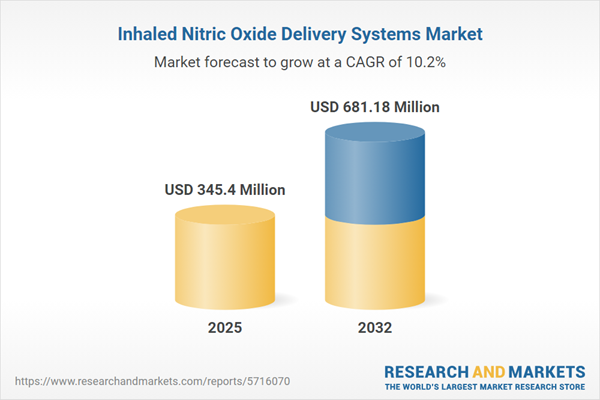Speak directly to the analyst to clarify any post sales queries you may have.
Advanced inhaled nitric oxide delivery systems are reshaping critical and respiratory care by offering precision therapy and supporting evolving healthcare models. Driven by ongoing innovation and new clinical protocols, these systems are increasingly integrated across hospital and home care landscapes globally.
Market Snapshot: Inhaled Nitric Oxide Delivery Systems Market
The inhaled nitric oxide delivery systems market grew from USD 312.74 million in 2024 to USD 345.40 million in 2025. The sector is expected to sustain robust momentum at a CAGR of 10.21%, reaching USD 681.18 million by 2032. Strong demand is propelled by advancements in digital monitoring, portable solutions, and alignment with modern respiratory and cardiovascular treatment needs. Healthcare organizations worldwide recognize these platforms' roles in improving patient management efficiency and outcomes.
Scope & Segmentation
- Application: Adult (hypoxemia in cardiac surgery, pulmonary hypertension), neonatal (hypoxemic respiratory failure, persistent pulmonary hypertension of the newborn), pediatric
- End User: Ambulatory care centers, clinics, home healthcare, hospitals
- Technology: Cylinder gas, electronic generator (fixed, portable)
- Delivery Device Type: Integrated systems, standalone
- Distribution Channel: Direct sales, distributors, online channels
- Mode of Delivery: Continuous, intermittent
- Regions: Americas (United States, Canada, Mexico, Brazil, Argentina, Chile, Colombia, Peru), Europe, Middle East & Africa (United Kingdom, Germany, France, Russia, Italy, Spain, Netherlands, Sweden, Poland, Switzerland, United Arab Emirates, Saudi Arabia, Qatar, Turkey, Israel, South Africa, Nigeria, Egypt, Kenya), Asia-Pacific (China, India, Japan, Australia, South Korea, Indonesia, Thailand, Malaysia, Singapore, Taiwan)
- Key Companies: Linde plc, Air Liquide S.A., Air Products and Chemicals, Inc., Messer Group GmbH, Taiyo Nippon Sanso Corporation, Air Water Inc., Bellerophon Therapeutics, Inc.
Key Takeaways
- Digital and remote monitoring technologies are now pivotal, enabling clinicians to manage and adjust inhaled nitric oxide therapy in real time both within and outside hospital environments.
- Demand for portable delivery systems is growing, especially in home healthcare and ambulatory settings, facilitating continuity of care and supporting patient mobility.
- The integration of artificial intelligence and predictive analytics is enhancing personalized treatment pathways, promising improved patient adherence and therapy optimization.
- Regional diversification is pronounced, with mature healthcare markets emphasizing integrated, sensor-equipped generators, while cost-effective standalone devices address access needs in emerging regions.
- Diversified distribution approaches combine traditional direct sales with online procurement platforms, expanding access and streamlining supply chain efficiency.
- Strategic partnerships and bundled service contracts are increasingly favored by institutional buyers seeking predictable maintenance costs and comprehensive supplier support.
Tariff Impact: United States Context
In 2025, newly imposed United States tariffs on imported medical equipment and specialty gases are increasing the cost structure for nitric oxide delivery systems. Supply chain delays, alternative sourcing strategies, and investment in local manufacturing are emerging as industry responses. Market participants are exploring service contracts and value-based pricing to maintain affordability for critical care providers and patients.
Methodology & Data Sources
This analysis uses a robust research framework combining in-depth desk studies of scientific literature, regulatory filings, and patents with structured interviews from clinicians and healthcare industry leaders. Data triangulation ensures insights accurately reflect the realities of demand, adoption, and therapeutic innovations within the sector.
Why This Report Matters
- Provides actionable intelligence for senior decision-makers on emerging techniques, market headwinds, and evolving competitive strategies for inhaled nitric oxide delivery systems.
- Assists hospital executives, manufacturers, and investors in evaluating innovation drivers, procurement trends, and region-specific opportunities.
- Informs planning for risk mitigation in the context of supply chain disruption, tariff implications, and regulatory updates.
Conclusion
The inhaled nitric oxide delivery systems market is entering a phase of advanced technological integration and regional adaptation. Strategic focus on analytics, collaboration, and adaptability will set industry leaders apart as patient-centric care models evolve.
Additional Product Information:
- Purchase of this report includes 1 year online access with quarterly updates.
- This report can be updated on request. Please contact our Customer Experience team using the Ask a Question widget on our website.
Table of Contents
3. Executive Summary
4. Market Overview
7. Cumulative Impact of Artificial Intelligence 2025
List of Figures
Samples

LOADING...
Companies Mentioned
The key companies profiled in this Inhaled Nitric Oxide Delivery Systems market report include:- Linde plc
- Air Liquide S.A.
- Air Products and Chemicals, Inc.
- Messer Group GmbH
- Taiyo Nippon Sanso Corporation
- Air Water Inc.
- Bellerophon Therapeutics, Inc.
Table Information
| Report Attribute | Details |
|---|---|
| No. of Pages | 181 |
| Published | October 2025 |
| Forecast Period | 2025 - 2032 |
| Estimated Market Value ( USD | $ 345.4 Million |
| Forecasted Market Value ( USD | $ 681.18 Million |
| Compound Annual Growth Rate | 10.2% |
| Regions Covered | Global |
| No. of Companies Mentioned | 8 |









